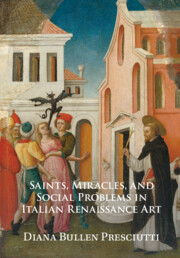Book contents
- Saints, Miracles, and Social Problems in Italian Renaissance Art
- Saints, Miracles, and Social Problems in Italian Renaissance Art
- Copyright page
- Contents
- Figures
- Acknowledgments
- One Introduction
- Two The Vita Icon Reimagined: New (and Old) Saints, New (and Old) Miracles
- Three Storytelling with Saints: Pictorial Narrative and Viewing Experience
- Four Girls in Trouble: Gendering Possession and Exorcism
- Five Assault, Amputation, Absolution: Visualizing the Power of Confession
- Six Thinking with Julian: Marital Violence and Elite Masculinity
- Seven Bernardino the Peacemaker: Visual Hagiography and Factional Violence
- Eight Cannibal Mothers: Picturing Madness and Maternal Infanticide
- Nine Making Innocence Visible (and Audible) in the Basilica del Santo
- Epilogue
- Bibliography
- Index
Eight - Cannibal Mothers: Picturing Madness and Maternal Infanticide
Published online by Cambridge University Press: 14 April 2023
- Saints, Miracles, and Social Problems in Italian Renaissance Art
- Saints, Miracles, and Social Problems in Italian Renaissance Art
- Copyright page
- Contents
- Figures
- Acknowledgments
- One Introduction
- Two The Vita Icon Reimagined: New (and Old) Saints, New (and Old) Miracles
- Three Storytelling with Saints: Pictorial Narrative and Viewing Experience
- Four Girls in Trouble: Gendering Possession and Exorcism
- Five Assault, Amputation, Absolution: Visualizing the Power of Confession
- Six Thinking with Julian: Marital Violence and Elite Masculinity
- Seven Bernardino the Peacemaker: Visual Hagiography and Factional Violence
- Eight Cannibal Mothers: Picturing Madness and Maternal Infanticide
- Nine Making Innocence Visible (and Audible) in the Basilica del Santo
- Epilogue
- Bibliography
- Index
Summary
Among the stories from the life of St. Vincent Ferrer in circulation in the years following his canonization in 1455, perhaps none was more famous than Vincent’s miraculous healing of a child who had been butchered and partially cooked by his insane mother.1 The version of the tale in the elaborate vita polyptych, painted for the church of San Domenico in Modena (Fig. 16), appears at first glance to depict unremarkable scenes of domestic life in fifteenth-century Italy (Fig. 118).2 The composition is divided by the architecture into four quadrants. At the bottom left, closest to the viewer, a woman with long blond hair, represented twice, prepares food outside of and inside an orderly kitchen. Further back in space, at the bottom right, we can identify figures seated at a table, perhaps for a meal. Upon closer examination, however, the illusion of domestic calm and normalcy unravels. The blond woman in the foreground is about to slaughter not an animal but rather a small child (Fig. 119). She betrays no hesitation as she steadies herself before lowering the knife that she wields in her right hand. The gleaming blade – the silver leaf has lost its original luster – guides the eye back to the kitchen, where the woman adds the dismembered body of the child to a steaming cauldron. To the left, on a shelf within a larder, more body parts rest in a shallow bowl.
- Type
- Chapter
- Information
- Saints, Miracles, and Social Problems in Italian Renaissance Art , pp. 258 - 289Publisher: Cambridge University PressPrint publication year: 2023



